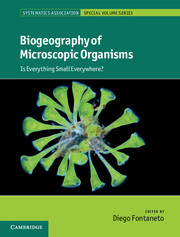Book contents
- Frontmatter
- Contents
- List of contributors
- Preface
- Part I Theoretical framework
- Part II Prokaryotes
- Part III Unicellular eukaryotes
- 5 Dispersal of protists: the role of cysts and human introductions
- 6 Everything is everywhere: a twenty-first century de-/reconstruction with respect to protists
- 7 Arcellinida testate amoebae (Amoebozoa: Arcellinida): model of organisms for assessing microbial biogeography
- 8 Everything is not everywhere: the distribution of cactophilic yeast
- Part IV Pluricellular eukaryotes
- Part V Processes
- Index
- Systematics Association Publications
- Systematics Association Special Volumes
- Plate section
- References
6 - Everything is everywhere: a twenty-first century de-/reconstruction with respect to protists
from Part III - Unicellular eukaryotes
Published online by Cambridge University Press: 05 August 2012
- Frontmatter
- Contents
- List of contributors
- Preface
- Part I Theoretical framework
- Part II Prokaryotes
- Part III Unicellular eukaryotes
- 5 Dispersal of protists: the role of cysts and human introductions
- 6 Everything is everywhere: a twenty-first century de-/reconstruction with respect to protists
- 7 Arcellinida testate amoebae (Amoebozoa: Arcellinida): model of organisms for assessing microbial biogeography
- 8 Everything is not everywhere: the distribution of cactophilic yeast
- Part IV Pluricellular eukaryotes
- Part V Processes
- Index
- Systematics Association Publications
- Systematics Association Special Volumes
- Plate section
- References
Summary
Introduction
The aphorism ‘Everything is everywhere, but the environment selects’ asserts that microbial taxa are found anywhere on earth that there is suitable habitat for them. It was crystallised in this form by Baas Becking (1934), who was in turn inspired by the ideas of Beijerinck (1913). The history of its establishment has been nicely summarised by O'Malley (2007) and its incorporation into contemporary thought described by de Wit and Bouvier (2006). It was further contextualised in terms of free-living protists by Fenchel and Finlay (2004). This concept (which we refer to hereafter as EiE) has recently been the focus of much heated debate in microbiology and protistology. This chapter will reassess the fundamental principles behind the EiE concept with respect to free-living protists in the light of recent findings and insights from twenty-first century molecular biology and microbial ecology. We do not intend to provide a survey of studies/taxa that apparently do or do not meet its predictions; work in this field is proceeding rapidly and such a survey would soon become obsolete. The studies cited here were not selected because we agree or disagree particularly strongly with them, but because they illustrate points of our discussion.
- Type
- Chapter
- Information
- Biogeography of Microscopic OrganismsIs Everything Small Everywhere?, pp. 88 - 110Publisher: Cambridge University PressPrint publication year: 2011
References
- 20
- Cited by



